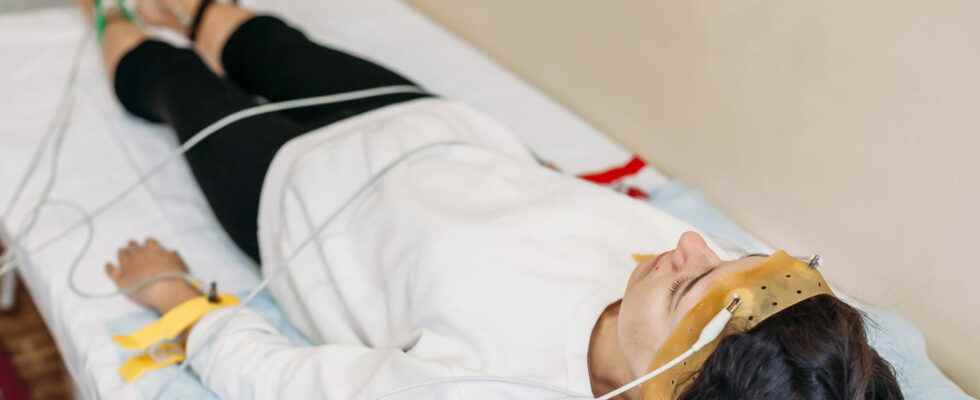Polysomnography is an examination that aims to determine the presence of sleep disorders. The examination is painless and most often performed in the hospital.
Definition: what is polysomnography?
There polysomnography East a neurophysiological recording of sleep during the night. “This is a comprehensive examination that aims to detect and quantify sleep disorders“, immediately introduces Doctor Robin Jouan, a sleep doctor. Using sensors, signals of respiration, heart rate, mouth breathing and oxygen saturation are recorded“. The patient is filmed during his sleep and a microphone is used to capture the snoring.
What is the difference with a polygraphy?
Unlike a ventilatory polygraphy often performed as first intention, polysomnography will also study:
- brain activity
- eye movements
- Leg and chin muscle activity
Indications: why do a polysomnography?
The examination is recommended in case of severe sleep disorders. According the recommendations of the High Authority for Health (HAS), polysomnography is indicated for sleep apnea exploration, hypoventilation syndromes or high upper airway resistance syndrome. “The examination is also recommended in case of suspected hypersomnia, narcolepsy, nocturnal epilepsy or if one is looking for periodic leg movements associated with restless leg syndrome. But not all sleep disorders result in polysomnography“ reports our interlocutor.
Polysomnography is most often performed in the hospital, clinic or sleep laboratory. The patient arrives at the hospital the day before, the exam takes place at night. “Electrodes are placed on his scalp, chest, face, and arms and legs“, reports doctor Robin Jouan. The patient does not need to be fasting and falls asleep when desired. “If he follows a treatment, the patient can take it, however no sedative is given to help him fall asleep“, explains the doctor. The exam lasts approximately 8 to 12 hours, some patients may remain hospitalized for several days, particularly in the case of hypersomnia. A machine records the data from the devices and then the doctor interprets the results.
Can polysomnography be done at home?
It is possible to perform polysomnography at home. The installation of the relief device is a medical act, “It is a sleep technician placing the sensors on the patient and takes care of machine control and settings“When he wakes up, the patient removes the entire device on his own. Doctor Jouan nevertheless recommends hospitalization to ensure that the examination goes smoothly, “if a sensor comes off, the test is flawed and you will have to start over“.
In general, a single polysomnography is sufficient to assess sleep. Thanks to the information collected, the doctor determines an index of apneas and hypopneas during sleep.
- An index equal to or less than 5 is considered the norm.
- Between 5 and 15, we diagnose mild sleep apnea
- Between 15 and 30, moderate sleep apnea
- Greater than 30, it issevere sleep apnea
Depending on the number of apneas, the patient is offered a device with a machine or a mandibular advancement orthosis which frees the back of the throat and does not block the flow of air.
What is the cost of a polysomnography and what reimbursement is possible?
On medical prescription, polysomnography is partly reimbursed by Social Security. Some mutuals can complete the coverage.
Thanks to Doctor Robin Jouan, psychiatrist and sleep doctor in Nice
